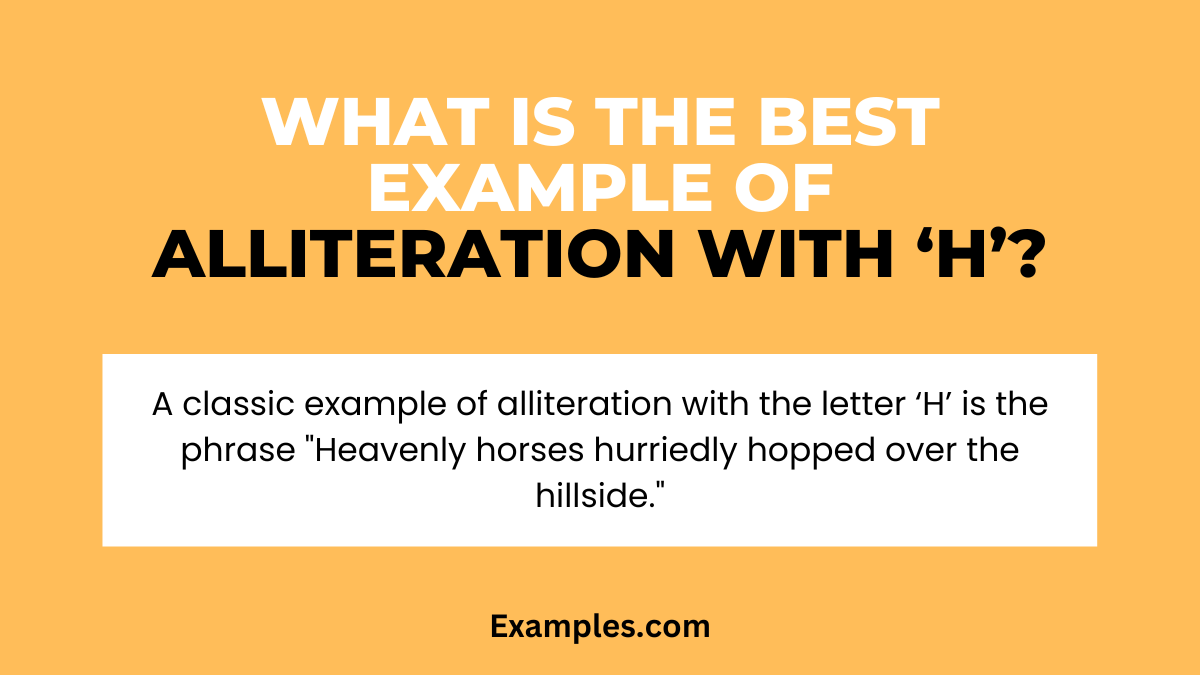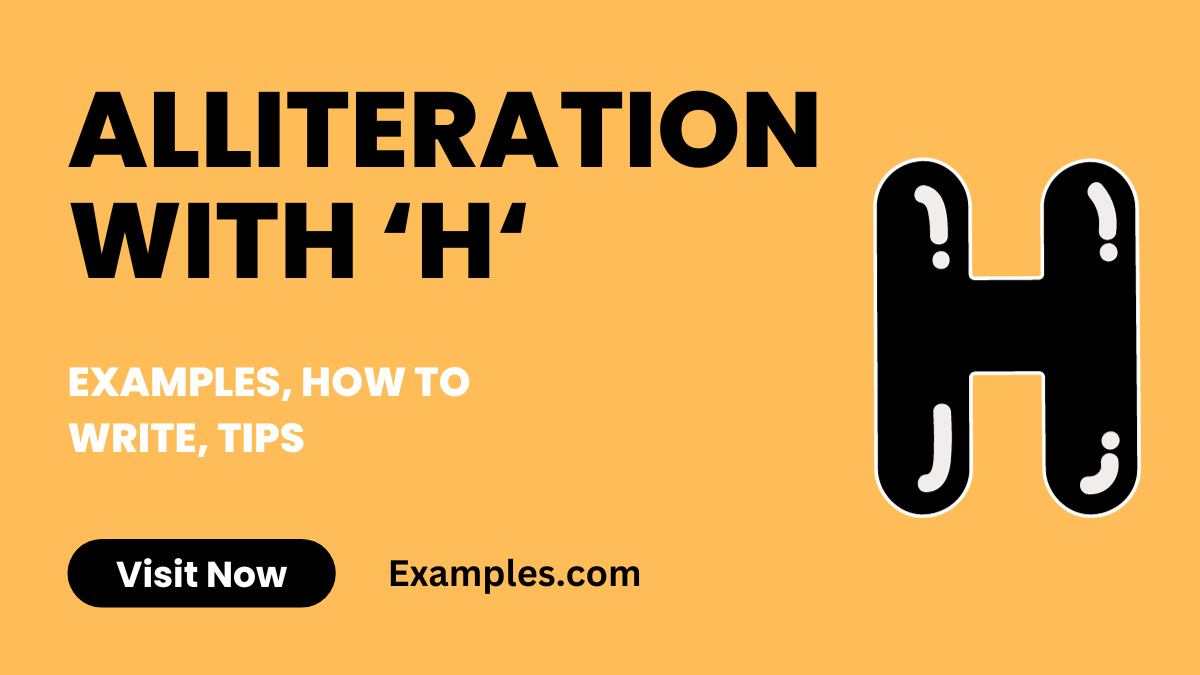19+ Alliteration with H Examples
Alliteration with ‘H’ adds a harmonious, hypnotic quality to written language. This literary device, characterized by the repetition of the ‘H’ sound at the start of closely connected words, creates a rhythmic and engaging effect. It’s a popular tool in poetry and prose, used by writers to convey mood, emphasize certain points, or simply to add a lyrical quality to their work. Writing alliteration with ‘H’ involves a keen ear for sound patterns and a playful approach to word choice. This style can range from whimsical and light-hearted to deeply evocative, depending on the context and intent of the writer. Mastering alliterations and assonance with ‘H’ can elevate your writing, adding a layer of sonic beauty that enchants readers.
Download Alliteration with 'H' Examples
Download Alliteration with 'A' to 'Z' Examples
What is the Best Example of Alliteration with ‘H’?

Example: A classic example of alliteration with the letter ‘H’ is the phrase “Heavenly horses hurriedly hopped over the hillside.”
Meaning: Alliteration is a literary device where consecutive words in a sentence or phrase begin with the same consonant sound. In the example “Heavenly horses hurriedly hopped over the hillside,” the consonant ‘H’ is repeated at the beginning of several words, creating a pleasing and rhythmic sound pattern. This technique is often used in poetry and literature to add emphasis, rhythm, and musicality to the text. In this Easy Alliteration, the repeated ‘H’ sound enhances the vivid imagery of horses and their movement, making the sentence more engaging and memorable.
20 Alliteration with ‘H’ Examples

Download Alliteration with 'H' Examples in PDF
Alliteration with the letter ‘H’ harnesses a harmonious blend of sounds that can be both heartwarming and humorous. The ‘H’ sound, with its hushed, breathy quality, brings a unique rhythm and softness to language. This type of alliteration is perfect for creating a serene, gentle atmosphere or for adding a hint of whimsy. Below are 20 unique examples of alliteration with ‘H’, each complemented by an alliteration in rhyme title that encapsulates the essence of the phrase.
- Harmonious Hills: “Harmonious hills, home to the hovering hawks.”
- Happy Hearts: “Happy hearts hum in harmonious hymns.”
- Hushed Harbor: “Hushed harbor holds hidden, heavenly secrets.”
- Hummingbirds in Harmony: “Hummingbirds hum in harmonious, heavenly dance.”
- Heavenly Hues: “Heavenly hues of the horizon at half-light.”
- Hidden Havens: “Hidden havens host hushed, heartfelt conversations.”
- Honeyed Harmonies: “Honeyed harmonies in the hazy, humid air.”
- Herald of Hope: “Herald of hope in the harrowing, harsh world.”
- Hopping Hares: “Hopping hares in the hazy, heathen fields.”
- Handsome Heroes: “Handsome heroes hailed from the historic highlands.”
- Hearty Harvest: “Hearty harvests herald a happy, healthy year.”
- Haunted Houses: “Haunted houses hold hidden, horrifying secrets.”
- Humble Homesteads: “Humble homesteads huddle in the hilly hinterlands.”
- Heaven’s Harmony: “Heaven’s harmony heard in the hushed night.”
- Hilarious Happenings: “Hilarious happenings at the high school homecoming.”
- Hallowed Halls: “Hallowed halls holding historic, heroic tales.”
- Holiday Happiness: “Holiday happiness in the hearts of the young.”
- Hazy Horizons: “Hazy horizons hold hopeful, heartfelt promises.”
- Hearty Handshakes: “Hearty handshakes held in high honor.”
- Hedgehog’s Haven: “Hedgehog’s haven hidden in the holly bushes.”
Alliteration Sentence Examples with ‘H’
Alliteration sentences with ‘H’ harness the breathy and sometimes hushed sound of the letter to create a rhythmic and often soothing effect. The ‘H’ sound can add a light, airy quality to phrases, making them memorable and engaging. Here are three examples:
- “Hazel’s hearty laughter echoed in the hollow hall.”
- “Hushed whispers hung heavily in the historic house.”
- “Harry’s hawks hovered high above the hilly horizon.”
Alliteration Examples with ‘H’ Name
Incorporating names that start with ‘H’ in alliteration adds a personal and often playful touch to sentences. Here are three examples:
- “Hannah’s happy hens pecked hungrily in the hay.”
- “Henry’s hounds howled harmoniously at the moon.”
- “Heidi’s handcrafted hats were hugely popular at the holiday fair.”
Alliteration Examples with ‘H’ Words
Alliteration with ‘H’ words creates a distinct, harmonious sound that can range from gentle to more pronounced. These examples showcase the versatility of the ‘H’ sound in creating engaging and rhythmical phrases for hard alliteration. Here are three examples:
- “Heavy hearts healed by the hopeful harmony.”
- “Hastily, he hoisted the heavy, hanging hammock.”
- “Hollow, haunting howls echoed through the hills.”
Alliteration Poem with ‘H’
An Alliteration poems with ‘H’ uses the repetitive ‘H’ sound to create a flowing and rhythmic experience, often adding a lyrical and emotional depth to the poetry. Here are three examples:
- “Hills and hollows, / Hearts and halos, / Hushed whispers of the willows.”
- “Harboring hopes, / Haunting horizons, / Heralding happiness in dozens.”
- “Honeybees hum, / Harvest comes, / In the heat of the summer sun.”
Alliteration Examples with ‘H’ for Kids
Alliteration for kids often features fun and friendly phrases that are easy to remember and recite. These examples can be particularly engaging for young learners, helping them with language development, including phonetics and vocabulary. Here are three playful and educational examples:
- “Henry the happy hippo hops in the hot sun.”
- “Hannah’s hilarious hamsters hum while eating honey.”
- “Harry the horse hurriedly hops over hurdles.”
Alliteration Beginning with ‘H’
Alliteration beginning with ‘H’ sets a specific tone in a phrase, often evoking a sense of harmony, humor, or heartiness. The ‘H’ sound in alliterative songs are being soft and breathy, is perfect for creating a light, airy feel in the language. Here are three examples that effectively use the ‘H’ sound:
- “Hearty hikers hike the high, hilly trails.”
- “Hazel’s handmade hats have happy, bright hues.”
- “Hooting owls herald the arrival of the twilight hour.”
How to Write Alliteration with ‘H’?
Writing alliteration answers with the letter ‘H’ involves incorporating words that begin with the ‘H’ sound in close proximity within sentences or phrases. This type of alliteration can add a harmonious and sometimes whimsical touch to writing. Here’s a step-by-step guide to crafting effective alliteration with ‘H’:
- Understand the ‘H’ Sound: Familiarize yourself with the sound of ‘H’. It is a soft consonant, producing a gentle and breathy sound, which adds a subtle rhythm to your writing.
- Choose a Theme: Decide on a theme or subject for your sentence or piece. This helps in selecting ‘H’ words that are relevant and coherent with your topic.
- Brainstorm ‘H’ Words: List words starting with the ‘H’ sound. Consider different types of words (nouns, verbs, adjectives) to add variety to your alliteration.
- Formulate Your Sentence: Construct a sentence or phrase using your chosen ‘H’ words. Arrange them to create a pleasing rhythm and ensure they make sense in the context of your theme.
- Read Aloud for Rhythm: The effectiveness of alliteration is often best judged audibly. Read your sentence aloud to ensure it has a pleasing rhythm and flow.
- Revise for Impact and Clarity: Edit your sentence to maximize its impact. Ensure that the alliteration enhances the message without compromising clarity.
- Incorporate into Your Writing: Seamlessly integrate your alliterative phrase into your larger text, whether it’s a poem, story, or an essay, to add stylistic flair.
Tips for Using Alliteration with ‘H’
Here are the Tips for Using Alliteration with ‘H’:
- Use Sparingly: Alliteration should enhance your writing, not dominate it. Use it to highlight key points or add a poetic touch but avoid overuse.
- Maintain Clarity: Clarity is crucial. Ensure your sentence remains clear and understandable, even with the use of alliteration.
- Vary Word Lengths and Types: Mix short and long ‘H’ words, as well as different types (nouns, verbs, adjectives), for a more engaging and varied rhythm.
- Consider the Mood: The ‘H’ sound is soft and subtle. Use it in contexts where a gentle, calming, or whimsical tone is desired.
- Test the Sound: Reading your work aloud helps you catch the rhythm and flow. The auditory impact of alliteration is crucial to its effectiveness.
- Avoid Forced Repetition: Ensure that the repetition of ‘H’ sounds natural and not forced. Forced alliteration can disrupt the flow of your writing.
- Explore Different Contexts: Try using alliteration in various forms of writing, from creative to academic, to understand its effect on your work.
By following these guidelines, you can effectively use alliteration figurative language to add a distinctive, rhythmic quality to your writing, making it more engaging and enjoyable for your audience.
What is the Alliteration with ‘H’ for Students?
Alliteration for students refers to the repetitive use of the ‘H’ sound at the beginning of words in close succession. It’s a valuable linguistic tool in educational settings, enhancing students’ engagement with language learning. This technique can aid in phonetic understanding, vocabulary building, and appreciation of literary styles. For younger students, it adds a playful element to learning, making it easier to memorize and understand new words. For older students, ‘H’ alliteration can be a creative device in writing, helping them experiment with style, rhythm, and sound in poetry and prose.
What is the Alliteration with ‘H’ for Adults?
Alliteration with ‘H’ for adults often serves a more sophisticated purpose compared to its use for children. In adult literature, ‘H’ alliteration can add a layer of depth and texture to writing, enhancing the auditory experience and emphasizing key themes or emotions. It’s commonly found in poetry, prose, speeches, and advertising. The use of ‘H’ alliteration in adult contexts might focus on creating mood, tone, or rhythm in a narrative, or it might be used for rhetorical effect in persuasive writing and public speaking.
What is the Effect of ‘H’ Letter in Alliteration?
The effect of the ‘H’ letter in alliteration is to create a soft, breathy sound that can impart a sense of calm, gentleness, or light-heartedness to a phrase. The ‘H’ sound is subtle yet distinctive, making it effective for drawing in the reader or listener without being overpowering. In alliteration literature, ‘H’ alliteration can create a lyrical quality, enhancing the musicality of a piece. It can also add emphasis in a subtle way, highlighting key points or adding to the mood of a text, whether it’s whimsical, serene, or even haunting.
What is the Alliteration ‘H’ Type of?
Alliteration with the letter ‘H’ is a type of consonantal alliteration, even though the ‘H’ sound is often softer and more subtle than other consonants. This form involves the repetition of the initial ‘H’ sound in adjacent or closely connected words. It’s a versatile literary device, used across various forms of writing. In poetry, it adds rhythm and musicality; in prose, it can enhance the narrative tone; in speeches and advertising, it can make key points more memorable. The famous alliteration is appreciated for its ability to add a gentle, rhythmic quality to language without being as forceful as other consonantal sounds.


